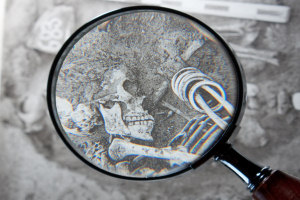New life for Nubian bones
16 Aug 2012
A two-and-a-half-year transatlantic search by researchers at The University of Manchester for the remains of thousands of Nubian skeletons will culminate in a fascinating workshop later this month.

The project has been led Professor Rosalie David of The University of Manchester and Professor Norman MacLeod of The Natural History Museum. Since 2010 they and a team of researchers have been identifying the whereabouts of the remains of bodies collected on the first archaeological survey of Nubia more than 100 years ago.
7,500 skeletons and mummies dating back to between 4,000BC and 1,000AD were excavated during the dig which took place in Southern Egypt from 1907 to 1911. It was a race against time for the American archeologist, George Reisner, and his team who were battling the rising waters building up behind the newly completed Aswan Low Dam.
The fact the area was flooded by the end of the excavation demonstrates the historical importance of what they found and the significance of the Nubian remains that were removed.
However, over the past century the remains have been scattered around the world; placed in various collections where their significance has been lost. Many have also been damaged, including a substantial number of skeletons which were destroyed by a bombing raid in London during the Second World War.
Dr Jenefer Cockitt from the Faculty of Life Sciences worked on the project: “We wanted to bring together as many of the remaining skeletons as we could in a virtual database so researchers could properly compare them. We also realised the full potential of these fascinating remains hadn't been properly fulfilled as research techniques have developed so much since 1911.”
Starting with the collection brought back to Manchester by the lead anatomist on the original dig, Sir Grafton Elliot Smith, Dr Cockitt and her colleagues began the painstaking investigation work to identify the bones. They used photos from the dig, notes from the archeological team, records of the shipments of remains into the UK and identification marks such as the grave number recorded on the bones themselves.
They also looked at the very well preserved collection at The Natural History Museum in London. Their investigations eventually led them around the UK and even to America to the Museum of Fine Arts in Boston.
Dr Cockitt recalls: “I had a real eureka moment in Cambridge when I found a packet of 400 cards that recorded the details of specific remains. Another high point was in America when we looked through thousands of photos that George Reisner had taken of the dig. It was hard work following the clues but so rewarding when we found what we were looking for. We began to feel that we knew the people behind the bodies and that we were giving them their voice again after all these years. ”
Professor MacLeod comments: “In the past, the dispersal of a collection inevitably resulted in the degradation of the collection’s significance and ease of access. But through the use of new technologies collections that physically reside in multiple locations can be brought back together in a virtual sense to support a greater range of scientific investigations than any of the host institutions could provide on its own. This project is a pioneering effort to move collections management into the virtual space and as such will have an influence far beyond the study of Nubian archaeology per se. It also shows what can be accomplished through inter-museum collaboration.”
In total Dr Cockitt and her colleagues have identified around 2,000 bodies. The researchers have used modern techniques to re-investigate the remains, focusing on what they can tell us about disease and trauma.
Images of the bodies have now been put on a virtual database, bringing them together for the first time since they were removed from the ground more than a hundred years ago. Descriptions of any known pathology or trauma suffered by the individual are recorded, along with a complete dental survey of all bodies with surviving teeth. It should prove to be a significant tool for researchers looking at disease.
As the project nears completion, the initial results will be presented at a workshop held at The Natural History Museum, London on the 29 and 30 August, titled “Palaeopathology in Egypt and Nubia: A Century in Review”. The workshop will also bring together researchers from around the world to discuss the history of the discipline in these areas, and what the next steps will be as new and increasingly powerful technologies are brought to bear on the subject. Tickets cost £45 and can be purchased online from The University of Manchester http://estore.manchester.ac.uk/
